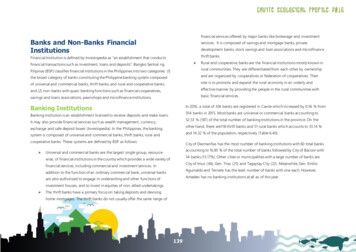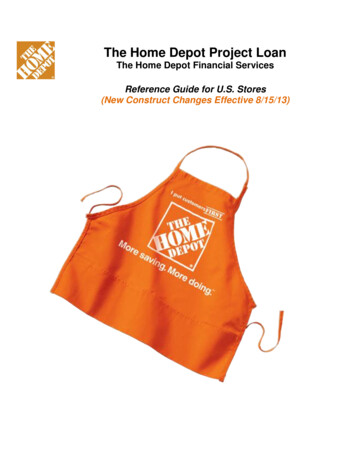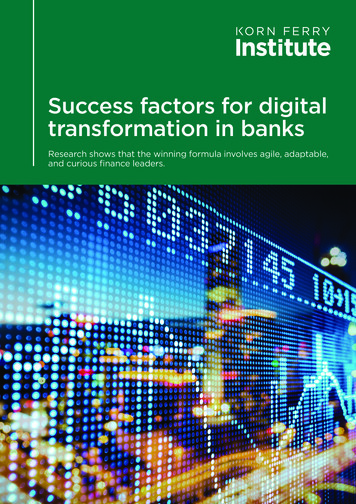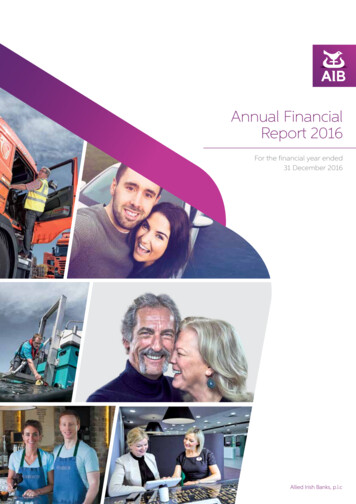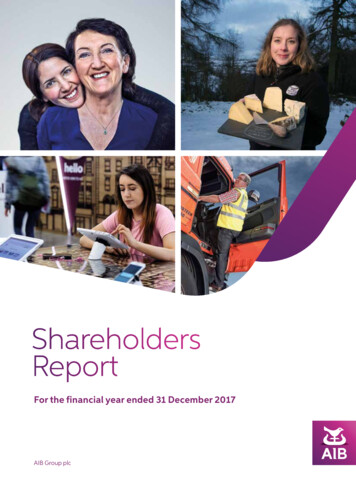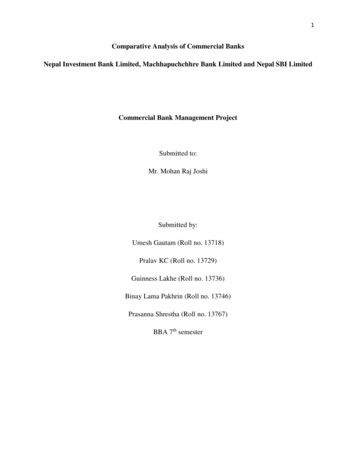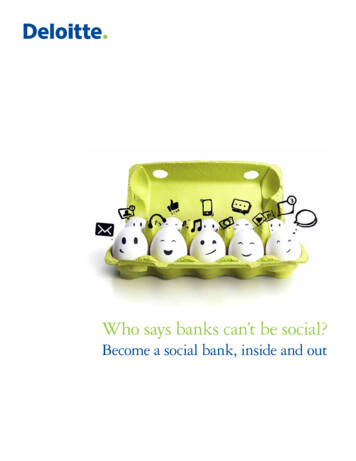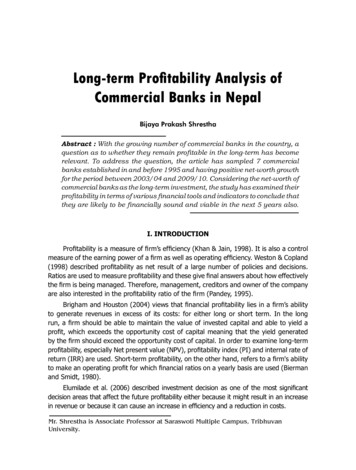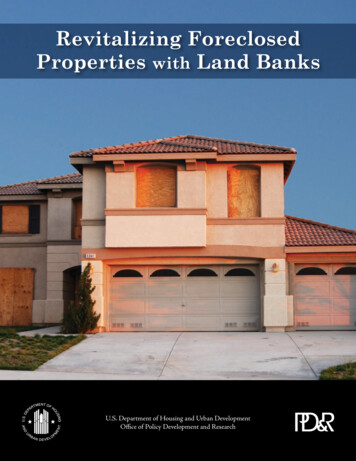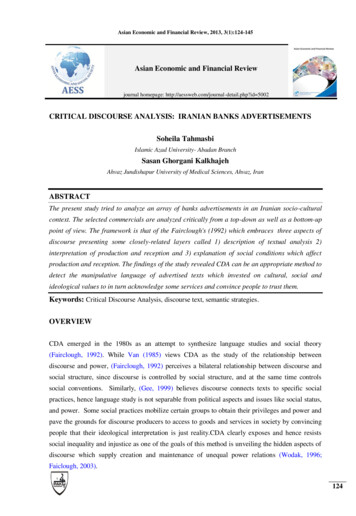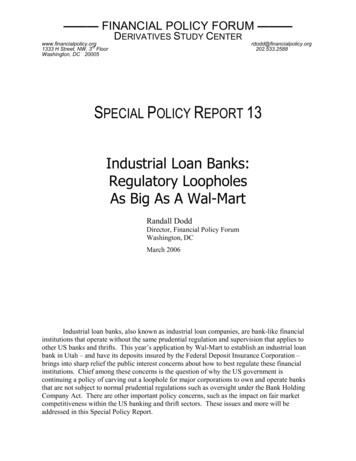
Transcription
——— FINANCIAL POLICY FORUM ———www.financialpolicy.org1333 H Street, NW, 3rd FloorWashington, DC 20005DERIVATIVES STUDY CENTERrdodd@financialpolicy.org202.533.2588SPECIAL POLICY REPORT 13Industrial Loan Banks:Regulatory LoopholesAs Big As A Wal-MartRandall DoddDirector, Financial Policy ForumWashington, DCMarch 2006Industrial loan banks, also known as industrial loan companies, are bank-like financialinstitutions that operate without the same prudential regulation and supervision that applies toother US banks and thrifts. This year’s application by Wal-Mart to establish an industrial loanbank in Utah – and have its deposits insured by the Federal Deposit Insurance Corporation –brings into sharp relief the public interest concerns about how to best regulate these financialinstitutions. Chief among these concerns is the question of why the US government iscontinuing a policy of carving out a loophole for major corporations to own and operate banksthat are not subject to normal prudential regulations such as oversight under the Bank HoldingCompany Act. There are other important policy concerns, such as the impact on fair marketcompetitiveness within the US banking and thrift sectors. These issues and more will beaddressed in this Special Policy Report.
BackgroundAlthough the issue of the regulatory loophole for ILBs is broader than Wal-Mart’sapplication, the importance of Wal-Mart for the US economy and its potential to increase inimportance with a bank charter acts to motivate and serves as an organizing theme to this report.In 2005, Wal-Mart applied to the Utah Department of Financial Institutions to establishan ILB with headquarters in Salt Lake City, Utah. In July of 2005, Wal-Mart applied to theFDIC for federal deposit insurance for the ILB. This effort by the giant retailer follows threeattempts in five years to unsuccessfully get into banking. Its previous plans to buy financialinstitutions in California and Oklahoma, and to partner with a bank in Canada, were thwarted bylegislation or disapproval by a federal financial regulator.Wal-Mart’s first attempt was in 1999. It sought to acquire a thrift, located in BrokenArrow, Oklahoma, which was already owned by the Walton family. The thrift, the Federal BankCentre, had been converted from a bank to a thrift in 1998 in order to qualify under a provisionin federal law allowing for “unitary thrifts” to be owned by non-financial institutions.1 Time wasnot on their side, however, as a change in federal law (The Financial Services Modernization ActP.L 106-102, commonly known as “Gramm-Leach-Bliley”) closed this loophole in 1999.It next tried to form a partnership with Toronto-Dominion Bank to open branches in itsstores. However in 2001 the Office of Thrift Supervision failed to approve the arrangement. Ina third attempt, Wal-Mart tried to purchase Franklin Industrial Bank, an ILB located in Orange,California in 2002. In testimony before the California legislature, Wal-Mart argued that theGramm-Leach-Bliley Act allows commercial entities like Wal-Mart to own ILBs.2 TheCalifornia legislature responded by passing AB 551 to amend California law so as to prohibitcommercial companies from acquiring California ILBs based on provisions in Gramm-LeachBliley.This time Wal-Mart has applied in Utah to establish a new state-chartered ILB and alsohas applied to the FDIC for federal deposit insurance coverage. In the process, Wal-Mart hasrequested that the ILB be exempt from the Community Reinvestment Act (CRA). The FDIC isexpected to decide on the issue in 2006.What Are Industrial Loan Banks?This Special Policy Report will use the term industrial loan bank (ILB) although thesefinancial institutions are also known as industrial loan companies. The term bank is most fittingbecause of the similarity of these financial institutions to banks as well as the fact that the state ofUtah allows their state chartered ILBs to use “bank” in their name.ILBs are chartered by state governments under state law and are subsequently supervisedby state bank authorities. Some of them issue deposits that are federally insured by the Federal1Unitary thrift holding companies are corporations, financial or non-financial, that own a single savings bank orsavings association.2California Senate Banking, Commerce and International Trade committee memo on AB 551, Aug. 27, 2002.1
Deposit Insurance Corporation (FDIC).3 Those that receive federal deposit insurance are alsoregulated at the federal level by the FDIC.Nearly all ILBs are owned by a holding company and thus are not stand-alone banks.Stand-alone banks are independent, unaffiliated with other financial institutions, and ownedoutright by a company that owns just the bank. In contrast, nearly all are owned through aholding company structure. These holding companies are often a major commercial or industrialcompany such as Toyota or BMW, or a major financial institution such as American Express orCitigroup.An ILB can serve any client, individual or business entity, and can offer most of the arrayof financial products available from normal commercial banks. These similar services include: Credit cards Consumer loans including those for vehicles, RVs, and home improvements Loans secured by brokerage accounts Commercial lending Real estate construction Equipment financing and leasing Subprime lending ILBs with less than 100 million in assets can issue demand deposits, while other canoffer checkable “NOW” accounts4 Access to the Fed wire, automated clearing house (ACH) and check clearing servicesof the Federal ReserveA Brief History of Industrial Loan BanksThe origin of ILBs dates to 1910 when Arthur J. Morris established the Fidelity Savingsand Trust Company of Norfolk, Virginia. Morris designed this new type of specially charteredbank to help provide credit to working people who were otherwise underserved by themainstream banking market. The name “industrial” comes from Morris’ plan to raise fundsthrough savings deposits from “industrial” workers.5 Originally, these banks were prohibitedfrom offering checkable deposits, and were funded instead by issuing “thrift certificates” or“certificates of investment.” When the FDIC was created in 1933, the agency decided not toinsure those deposits.Morris’ institutions presaged today’s microfinance institutions in developing countries.His banks made credit available to working people without the usual requirements for collateral.Instead, the “Morris plan” banks relied upon the promises of loan cosigners.“The cosigners need have no financial resources but must be as good as theborrower (Herzog 1928, p.19). Despite co-signers being formally obligated torepay the loan, banks did no expect to recover defaulted amounts from co-signerswith any frequency (Herzog 1928, p.20). Thus, co-signers were not viewed as asource of collateral or funds in the event of default. Finally, there was no3Jackson, William. 2005. Congressional Research Service Report for Congress, February 11, 2005.Sutton, George. 2002. “Industrial Banks.” Consumer Finance Law Quarterly Report, Spring 2002.5Phillips, J. Ronnie and David Mushinski. 2001. “The Role of Morris Plan Lending Institutions in ExpandingConsumer Micro-Credit in the United States David, Department of Economics,” monograph Colorado StateUniversity. The paper provides an excellent history, and Professor Phillips also provided a helpful interview in thepreparation for this report.42
collateral required on a loan and the length of maturity was never more than oneyear.”6This model for consumer credit, known as “Morris plan” banks, proved highlysuccessful. By 1915 there were Morris plan banks in 56 cities; by1931 there were 109 operatingin 142 cities; and by 1935 they had become the leading provider of consumer credit to workers inthe United Sates.Today, these ILBs play a very different role in financial markets and the US economythan that envisioned by either Morris or the legislation that created them decades ago. Instead ofsmall financial enterprises catering to otherwise neglected working people, they are owned byhuge multinational commercial and financial corporations in order to reduce their regulatoryrequirements. They also have grown significantly in size and their activities and role in theeconomy have grown far beyond the original purpose intended by Congress. As a recent GAOreport put it, “Some ILCs have evolved into large, complex financial institutions with extensiveaccess to capital markets.”7The change has not been gradual. Whereas the total sum of all ILB assets was less than 4 billion in 1987, the amount mushroomed to more than 140 billions by 2004.8 At the sametime, the number of ILBs declined from 106 to 57. This pushed the average size of a ILB fromless than 36 million in 1987 to over 2.5 billion in 2004 – indicating that there is much greaterconcentration in this sector than ever before. One ILB has over 66 billion in assets, and thereare six ILBs listed amongst the largest 180 financial institutions in the United States. Of thelargest 16 depository institutions supervised by the FDIC, three are ILBs.9 Most ILBs are ownedby a holding company, and these ILBs own 99% of all ILB assets.10IBLs operate in seven states, but 99% of ILB assets are in just three states: Utah,California and Nevada.11 The FDIC insures 56 of these 57 financial enterprises. There are 29Utah registered ILBs, which hold 82% of all ILB assets. These are owned by major corporationssuch as American Express, BMW, Citigroup, General Electric, General Motors, Merrill Lynch,Morgan Stanley, Pitney Bowes, Sears, UBS, Volkswagen and Volvo.12 The GAO reports thatthree of the six ILB charters issued since June 2004 are owned by non-financial commercialfirms.13From 1985 through early 2004, there were 21 failures of ILBs. These collapsed ILBswere mainly small finance companies taking on risky customers. The two largest failures werePacific Thrift and Loan and Southern Pacific Bank – whose assets totaled 1.1 billion. Thesefailures represented a small percentage of total ILB assets, and together resulted in about 105million in losses for the bank insurance fund. However, according to the Federal Reserve Board,6Herzog, Peter W. 1928. The Morris Plan of Industrial Banking. A. W. Shaw Company:Chicago. Quoted in Phillips and Mushinski (2001), page 6.7Government Accountability Office. 2005. “Recent Asset Growth and Commercial Interest Highlight Differencesin Regulatory Authority.” GAO-05-621, September 2005. Subsequently referred to as GAO. 2005.8GAO. 2005.9GAO. 2005.10GAO. 2005.11In addition to the big three, the other states include: Colorado, Hawaii, Minnesota.12Jackson, William. 2005. Congressional Research Service Report for Congress, February 11, 2005.13GAO. 2005, page 73.3
the failure of the former was due to trouble with the parent company and how it interacted withits ILB.14How Are ILBs Regulated?STATE LAWILBs are state chartered financial institutions that are subject to state laws and supervisedby the banking authority of their home state. State charters for ILBs are not very limiting as tothe type of activities undertaken by ILBs.15 A recent GAO report put it clearly and succinctly,“Banking laws in California, Nevada, and Utah have undergone changes that generally placeILCs on par with traditional banks. Thus, like other FDIC-insured depository institutions, ILCsmay offer a full range of loans [and] may “export” their home-state’s interest rates tocustomers residing elsewhere.”16Although ILBS can engage in a similar range of financial activities, these state charteredfinancial institutions face some differences from state to state. For example, California andColorado prohibit non-financial firms, such as General Motors or Wal-Mart, from owning ILBs.Also, California law prohibits ILBs from accepting checking or demand deposits. Some statesrequire IBLs to obtain deposit insurance from the FDIC as a condition for issuing deposits.Despite being state-chartered, ILBs are allowed to “export” their home state’s interestrates for transactions in other states. This allows an ILB to charge the up to the maximuminterest rate allowed by the state in which it is chartered irrespective of which state the customeris located. This means that any interest rate ceiling in the chartered-state applies for transactionsnationwide. Neither Utah nor Nevada – which together make up 89% of all ILB assets – place acap on interest rates, and so the ILBs located in those states face no anti-usury limits on theinterest rates they charge borrowers.The variation in law from state to state can lead to a lowering of prudential regulatorystandards. According to David Poulsen, President of the American Express Centurion Bank,ILBs grew in popularity in specific states partially because of the states’ “low cost of operation,simple and clear consumer credit code, and generally business friendly state legislature.”17 Astory in Credit Card Management Magazine expressed this more precisely, “In the daysimmediately preceding the enactment of CEBA [Competitive Equality Banking Act of 1987],when it became apparent that ILBs were to be preserved as a vehicle for non-bank owners,several well-known financial-services companies feverishly sought out the available ILC chartersin Utah. The California and Colorado ILC do not appear as attractive as those in Utah. That isbecause Utah has fewer restrictions to impede the growth and potential usefulness of ILBs asvehicles with which to conduct nationwide lending and deposit taking.”1814See more on this below. Taken from accounts in GAO report, p. 61.Jackson, William. 2005. Congressional Research Service Report for Congress, February 11, 2005.16GAO. 2005, page 21.17FDIC. 2003. “The Future of Banking: The Structure and Role of Commercial Affiliations,” FDIC SymposiumJuly16, 2003. FDIC website. http://www.fdic.gov/news/conferences/future transcript.html18Boomstein, Anita L. 1993. “A non-bank tool regulators can't k
Industrial Loan Banks: Regulatory Loopholes As Big As A Wal-Mart Randall Dodd Director, Financial Policy Forum Washington, DC March 2006 Industrial loan banks, also known as industrial loan companies, are bank-like financial institutions that operate without the same prudential regulation and supervision that applies to other US banks and thrifts. This year’s application by Wal-Mart to .
